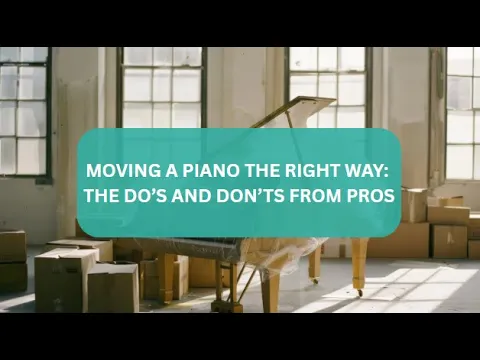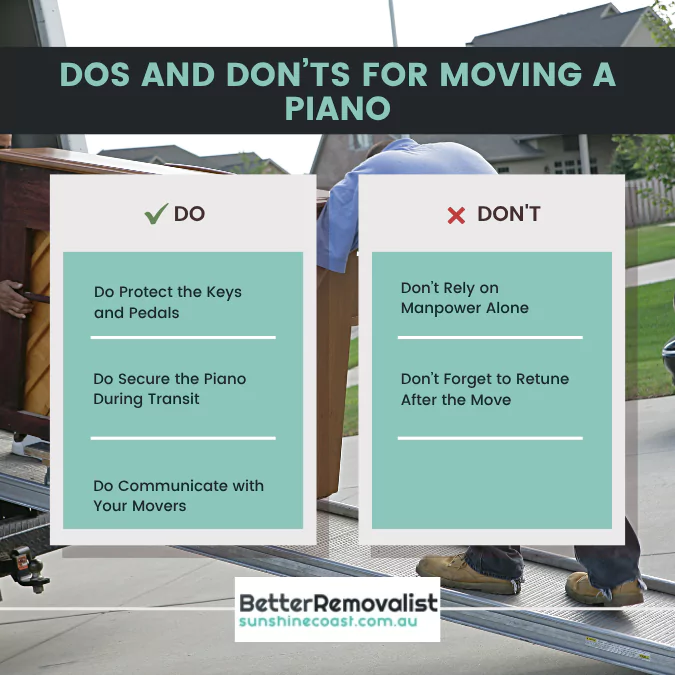


Moving a piano takes not only strength and power, but also precision, planning and safety for a seamless experience. Whether it’s a cherished family treasure or the centrepiece of your living room, your piano requires more than just a fast lift and transport. The weight, size and delicate internal mechanics make it one of the most difficult household things to move.
If you live in Queensland and plan on moving, professional assistance is more of a requirement than a luxury. Experienced removals Sunshine Coast understand that pianos require more than generic moving techniques. This blog will provide you with expert backed dos and don’ts to help you protect your instrument and your back during the move. Dive into the essential tips for moving your piano more smoothly, safely and stress free.

Not all pianos are created equally. From upright to baby grand, each style necessitates a distinct moving method. Understanding your model is the first step in identifying the safest way to move. For instance, an upright piano is heavy but more compact, while a grand piano may require partial disassembly.
When you hire pros, they will examine the type of piano and recommend the safest path, whether it be stairwells, elevators, or slanted curves. To address such a challenging situation, experienced removalists Sunshine Coast bring moving dollies, skid boards and ramps. Attempting a DIY procedure, particularly without the necessary tools, is a common mistake that results in damage or injury.
The keys and pedals are among the most vulnerable parts of a piano. Before moving, always close and lock the keyboard lid to prevent it from flapping open. If it does not lock then wrap it securely with soft padding or a moving blanket.
To prevent accidental bending or snapping, pedals should also be cushioned with foam or cushioning. These little precautions can have a significant impact on the instrument’s internal integrity. Professionals often protect these parts with specialised packaging to prevent unwanted movement during transit.
While it is tempting to call a few strong friends and tackle the move yourself, this decision often backfires. Pianos can weigh anywhere between 150 to 600 kilograms. More importantly, the uneven weight distribution makes them incredibly awkward to lift or shift without technique.
Lifting without experience can lead to back injuries, broken toes or dropped instruments. That is why hiring trained removalists Sunshine Coast is essential; they not only have the strength but also the expertise to handle tight turns, stairs and loading docks with ease. Using proper lifting straps, dollies and team coordination, they ensure a safe move for everyone involved.
Once the piano is successfully moved out of the house, the next crucial step is loading it onto the moving truck. This part of the process is often underestimated. Simply placing the piano inside a van and hoping it stays put won’t cut it. You must ensure it’s tightly secured to avoid tipping or shifting during transport.
Professionals use ratchet straps and padded barriers to keep the piano stable and upright. The truck is usually arranged in such a way that the piano is placed against the wall, with adequate cushioning on all sides. This helps absorb any shocks or vibrations during the ride. Incorrect positioning can lead to severe internal damage, especially if the truck hits bumps or takes sharp turns.
Pianos are sensitive to temperature, humidity and movement, all of which can affect their tuning. Even the most carefully handled piano can go slightly out of tune after a move due to subtle shifts in string tension and soundboard alignment.
It is wise to let the piano acclimate to its new environment for a week or two before getting it retuned. This allows it to adjust to the room’s temperature and humidity. Hiring a professional tuner post move ensures that the instrument sounds as beautiful as it looks. Many reputable removalists in Sunshine Coast even include recommendations for trusted local piano tuners as part of their service.
Clear communication is key to a successful piano move. Before the big day, walk your movers through the property, highlighting narrow corridors, steps or any obstructions. Let them know about the piano’s dimensions, weight and type so they can arrive fully prepared.
This also includes discussing the final placement of the piano at your new home. Whether it’s on the first floor or in a basement music room, good planning ensures the moving team brings the right equipment and manpower. The more details you provide, the smoother the entire process becomes.

Moving a piano is no small feat; it demands a mix of strategy, tools and trust in trained professionals. From securing delicate parts to choosing the right transit approach, every step needs attention. Hiring experienced removalists takes the guesswork out of piano moving. So next time you’re relocating your prized instrument, keep these dos and don’ts in mind and let the experts do the heavy lifting while you plan your first tune in the new space.

